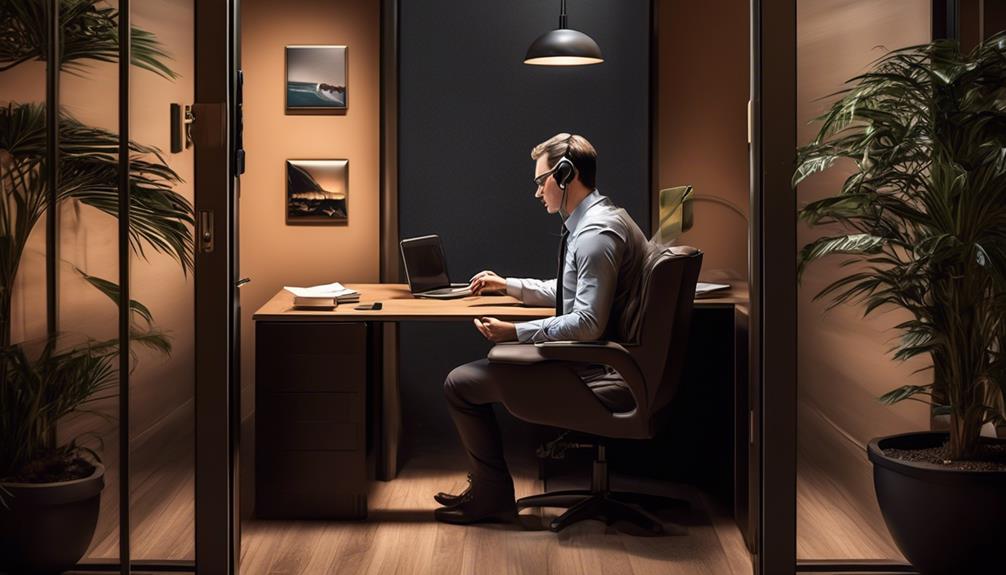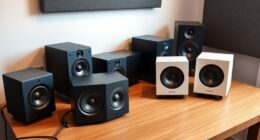When field recordings capture ambient sounds, they turn ordinary audio into an immersive experience, taking the listener to various environments. These recordings do more than just capture the main subject; they also capture the whole sonic landscape, offering a rich background noise and atmospheric elements.
But how do these ambient sounds impact the final production? And what techniques are used to capture them authentically?
Join us as we explore the significance of ambient sounds in field recordings and their influence on the listener's perception.
Key Takeaways
- Ambient sounds play a crucial role in adding depth and realism to audio projects.
- Specialized microphones and techniques are used to capture ambient sounds authentically.
- Ambient sounds profoundly influence listeners' experiences, evoking various emotions and enhancing storytelling.
- Balancing ambient sounds with primary audio elements is crucial in the mixing process.
Importance of Ambient Sounds in Field Recordings
Ambient sounds play a crucial role in field recordings by adding depth and realism to audio projects, creating a sense of environment and atmosphere.
When we make field recordings, we make sure to capture the ambient sounds, which are essentially the background noise or environmental sounds in a given location. These ambient sounds, whether from nature, urban areas, or indoor settings, are what make field recordings so unique and captivating.
In music production and sound design, we make sure to use these ambient sounds to enhance the auditory experience, adding a layer of authenticity and immersion to the final piece. It's incredible how just a 2-second clip of ambient sound can transport the listener to a specific place or time, evoking emotions and enhancing storytelling.
The importance of ambient sounds in field recordings can't be overstated. They've the power to immerse listeners in a particular setting, creating a sensory experience that goes beyond just hearing.
This is why we make sure to capture these ambient sounds in their purest form, allowing them to enrich and elevate the overall audio project.
Techniques for Capturing Ambient Sounds

When recording ambient sounds, we employ specialized microphones and recording techniques to capture the organic essence of our environment. Choosing the right recording equipment is crucial in capturing high-quality ambient sounds. For instance, omnidirectional microphones are ideal for capturing the overall ambiance of an environment, while shotgun microphones are useful for isolating specific sounds in diverse settings. Additionally, experimenting with different microphone placements and techniques, such as stereo and surround recording, allows us to capture a wide range of environmental diversity.
Editing techniques also play a significant role in refining captured ambient sounds. Post-recording processes like noise reduction, equalization, and spatial processing help in enhancing the clarity and immersive quality of the recordings. Moreover, employing advanced editing tools like convolution reverbs can add a sense of spatial realism to the ambient sounds, further enriching the overall audio experience.
When capturing ambient sounds, it's essential to consider the environmental diversity of the recording locations. Conducting field recordings in various settings such as forests, urban areas, or indoors provides access to a rich tapestry of ambient sounds, adding depth and authenticity to audio projects.
Impact of Ambient Sounds on Listener Experience
Listeners' experiences are profoundly influenced by the evocative power and immersive qualities of ambient sounds. The psychological effects of ambient sounds on listeners are profound, as they can evoke a wide range of emotions, from tranquility to excitement.
When used in creative storytelling, ambient sounds elevate the narrative, adding depth and authenticity to the listening experience. They transport the listener to different environments, creating immersive environments that enhance the overall impact of the story.
In music, film, and virtual reality, carefully selected ambient sounds significantly influence the mood and atmosphere of the content, shaping the listener's emotional response. The use of ambient sounds can contribute to stress reduction and relaxation, creating a calming and soothing effect on the listener.
Utilizing Ambient Sounds in Audio Production

In audio production, we often incorporate ambient sounds, captured through field recordings, to add depth and realism to our projects.
Creative applications of ambient sounds in audio production range from creating immersive soundscapes in music to enhancing the atmosphere of film and video game soundtracks. These sounds can also be used to evoke specific emotions or transport the listener to a particular location.
When integrating ambient sounds into a mix, careful attention to mixing considerations is crucial. Balancing these sounds with the primary audio elements, such as vocals or instruments, requires a nuanced approach to ensure they complement rather than overwhelm the overall mix.
Additionally, post-processing techniques play a vital role in refining ambient sounds. Applying effects like reverb, delay, and EQ can help tailor these recordings to fit seamlessly within the sonic landscape of a production.
Moreover, manipulating ambient sounds through techniques such as time-stretching or granular synthesis can yield unique textures and atmospheres, expanding the creative possibilities in audio production.
Preserving the Authenticity of Ambient Field Recordings
To maintain the integrity of ambient field recordings, it's essential to preserve the original environmental context and background noise captured during the recording process. The importance of unaltered field recordings can't be overstated, as any manipulation or alteration can compromise the authenticity of the ambient sounds.
Capturing the essence of the environment in its truest form is paramount in preserving the natural soundscape. By minimizing human-made or artificial noises during the recording process, the purity of the environment's sonic landscape can be upheld. Additionally, documenting the exact location, time, and conditions of the recording is crucial to provide context and authenticity to the captured ambient sounds.
Preserving the natural soundscape requires the use of high-quality recording equipment and techniques to accurately capture the nuances and subtleties of the ambient environment. It's imperative to avoid any post-production manipulation that could distort the original sonic characteristics of the recording.
Frequently Asked Questions
What Does It Mean to Say Field Recordings Capture Ambient Sounds?
We capture the atmosphere and natural surroundings through field recordings, encompassing environmental noise and providing authenticity to music and sound design.
These recordings immerse listeners, making them feel present in the environment.
The captured ambient sounds offer insights into specific locations' sonic characteristics and contribute to a deeper understanding of environmental acoustics.
This process enhances the overall experience and adds depth to the creative projects we work on.
How Is Ambient Sound Recorded?
When recording ambient sounds, we capture diverse soundscapes, from the tranquility of nature to the hustle and bustle of urban environments. We focus on creating atmospheric recordings that convey the unique essence of each location.
Our equipment selection and proximity to the subject are crucial in capturing the authentic sounds effectively. This approach ensures that our field recordings preserve the true atmospheric character of the environments we record.
What Equipment Is Used to Record Ambient Sound?
We use specialized equipment like omnidirectional or stereo microphones for capturing ambient sounds effectively. Noise cancellation, proper microphone placement, and understanding soundscapes are crucial for high-quality recordings.
Additionally, we rely on windshields and shock mounts to reduce unwanted noise and handling vibrations. Portable power sources and memory cards are also essential for extended field recording sessions.
What Is a Field Audio Recorder?
We understand the importance of a field audio recorder in sound capturing techniques.
This portable equipment is crucial for capturing ambient sounds in diverse locations.
It plays a vital role in creating immersive experiences through the recording of 3D and binaural audio.
Understanding its significance in music production and sound design is essential for mastering the art of environmental sound recording.
Conclusion
In conclusion, capturing ambient sounds in field recordings is like opening a window to the soul of the environment. It's not just about adding background noise, but about immersing the listener in the raw, untamed beauty of the world around us.
The impact of these sounds is profound, shaping the experience of music and audio projects in ways that transport and transform.
So, let's continue to cherish and preserve these authentic recordings, for they're the heartbeat of our sonic landscape.










